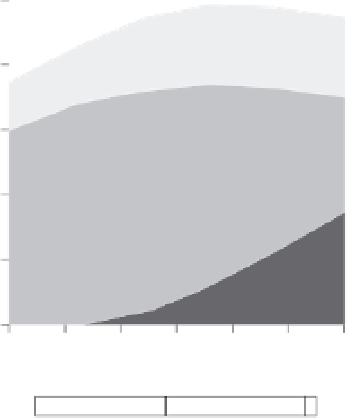Environmental Engineering Reference
In-Depth Information
Clearly, the most efficient solar housing must be
planned and built de novo. On the other hand, many
large-roofed, single-story buildings with low energy
needs (warehouses, many offices, factories) could use
their roofs to generate surplus heat or electricity for
neighboring structures. But it may be impractical to
solarize an energy-intensive factory in a decentralized
manner, and impossible to do so for high-rises or down-
towns: they would have to rely on transmitted electricity
supply from central photovoltaic stations. These realities
call for gradual but fundamental adjustments. A combi-
nation of very low population growth (even a decline),
enormous opportunities for higher conversion efficien-
cies, and continuing shifts toward lower energy inten-
sities make it possible to imagine not only stationary but
even declining TPES among the world's richest 1 billion
people. Moderation of extraordinarily meaty Western
diets would greatly reduce farming energy subsidies, and
concerns about climate change and the safety of nuclear
generation should favor rational uses of energy.
In contrast, the still growing populations in Asia,
Latin America, and Africa need higher TPES. Their tradi-
tional reliance on biomass energies has been one of the
principal causes of deforestation, desertification, and ero-
sion. Some of their cooking needs can be met by cultiva-
tion of suitable fuel wood species and by diffusion of
improved stoves, but the use of crop residues for fuel
should be generally discouraged, and the production of
biomass-derived ethanol makes sense only in some tropi-
cal land-rich countries (even there, such conversion
could reduce the food harvests). Some countries still
have considerable untapped hydro potential, and wind
and geothermal electricity can make important local and
regional contributions, but both the resource magnitudes
and power densities dictate that solar radiation must
eventually be the largest component of
renewable
energetics.
It will take long time before renewable conversions
supply the energies needed for farming subsidies or for
most industries and transportation. And even small- and
medium-scale uses of new renewables will be compli-
cated by their seasonality, intermittence, and uneven
spatial distribution. These realities belie any simplistic
notions about the near-term reach of large-scale renew-
able conversions. Lovins (1976) anticipated that in the
United States renewable conversions would supply about
32 EJ by the year 2000 (30% of the total), but after the
subtraction of large-scale hydrogeneration, new renew-
ables contributed just 3.2 EJ, only one-tenth of Lovins's
forecast (fig. 12.10). Sørensen (1980) put the share at
12.10 Amory Lovins's 1976 forecast for the year 2000 of the
share of renewable energies in the U.S. TPES. The actual
achievement was 1 OM lower.









































